Pilots Work On Maine's Seas and Rivers: Dangerous and Necessary
Some worry about cruise ship lawsuit implications on their livelihoods
BAR HARBOR—Penobscot Bay River pilot captains David Gelinas and Prentice “Skip” Strong don’t ever want to jump between moving boats. A river pilot prefers to step and to climb, to predict all the factors that might impact them.
According to its website, the Penobscot Bay Pilots “are responsible for guiding any vessel required to take a pilot upon the waters of Penobscot and Frenchman Bay as well as Penobscot River.”
They board vessels off shore, 24 hours a day, 365 days a year if the weather permits. Their job is to navigate those ships to port. And then, they guide them out again.
To move between boats safely, that pilot has to depend on the skills of local captains and their knowledge of the sea, the wind, and the boats. It’s a system of connected aspects: man, water, wind, boats.
Some days and nights in Frenchman Bay off Mount Desert Island predicting that system and navigating it safely as they move from one boat to another is a bit easier than others.
On Saturday afternoon, the men’s voices were calm on the scanner.
“Let’s go port side. 9.6 knots.”
“That seems risky.”
“Okay. 9.4.”
“Okay. See you in . . . 90 seconds.”
Less than five minutes later, it was done.
On Friday afternoon, the approach and radio traffic was a lot more seemless as one of the pilots moved from the small Acadia Pilot to the CAT ferry (Alakai).
Imagine you’re piloting a boat in Frenchman Bay. Your goal? It’s to pretty much smash sides with the giant boat right next to you. And that boat? It’s a goodly 8,127 tons with a 12-foot draft and it might have over 800 people onboard.
Then, you have to keep the boat close enough and stable enough to let a man you know really well scramble up and onto a ladder slung over the side that can be longer than 20 feet and head into another vessel.
If he falls, he hits either frigid ocean waters, your boat’s deck, or in between the two boats. None of these are great options.
The boats are not still during all of this. They usually slow to eight knots or so. The pilot boat matches that speed, slips alongside. The pilot heads to the bow and gets ready to climb.
On a clear day, it’s dangerous. On a foggy day or a day with some nasty swells? It’s something else entirely.
“I love this,” Gelinas, president of Penobscot Bay & River Pilots Association, said before he headed up a ladder to the CAT ferry. He smiled in a way that reached his eyes and he pulled on his gear, ready to go from one small boat to one giant one as CAT passengers peered over the side, waving.
“The pilots are amazing,” Captain John Kachmar said after dropping off Gelinas on the CAT so that Gelinas can pilot the behemoth ferry through a roughly 600-foot channel between lobster buoys and gear and back to its port.
Gelinas can only get on the CAT because of Kachmar’s steady knowledge of the boat, the water, and just how hard it is to get two boats next to each other and not damage either one.
Things can go wrong.
In 2019 and 2020, two pilots were killed in the New York-New Jersey area in falls from pilot ladders in two separate boarding incidents.
“It’s dangerous,” Kachmar said. “I try to keep it less dangerous.”
“It takes a certain kind of person to do this job,” Gelinas said of Kachmar as Kachmar called in the boat’s position to the CAT. “We’re lucky to have people like him.”
Before the drop-off, Kachmar had already deftly moved the boat past multiple anchorages hosting cruise ships of various sizes, beyond the harbormaster’s at Ells Pier, and past a kayaking group.
“You’re crashing into another ship. It’s fun,” Kachmar said. “It’s not normal.”
Kachmar said that he’d never imagined he’d be bringing pilots to the CAT or cruise ships or barges for a living. He’d majored in business, focused in marketing, worked with insurance companies before landing in Southwest Harbor for good where he owned and ran Wilbur Yachts for years. Now, he spends his days watching—watching the instruments, watching the ocean, watching the ships, watching Sternman Vinny Abbott and Gelinas and trying to make sure everyone stays safe.
There’s a lot of skill involved in all these men’s jobs, even when they make it look easy. That skill is honed by training and years of practice.
Once Gelinas is on a ship like the CAT or a barge or a cruise ship, he will have to steer ships that are sometimes 1,000 feet long through a small channel through lobster gear, past porpoises. The wind might blow. The sea might swell. The sea will want to make that ship move sideways. His job is to keep that ship going right where it’s supposed to.
Once he was on the CAT, Gelinas headed the ferry in to Bar Harbor.
“There’s nothing else out here that moves like that,” Kachmar said, following behind. The CAT can glide through the water at up to 46 knots, he said.
“You can’t catch him,” Abbot said.
“Not even close,” Kachmar agreed. Unlike the CAT, the pilot boat runs at a lot less speed than that. “But maybe we can watch him turn around.”
The CAT has to execute a 180-degree maneuver in the harbor before docking at the Bay Ferries Terminal at the town-owned site on Route 3.
The PenBay pilots take care of the ports of Bar Harbor, Bangor/Brewer, Bucksport, Rockland, and Searsport
Pilots like Gelinas and Prentice “Skip” Strong; captains like Kachmar, and sternmen like Abbott are all part of a system of commerce and of safety that exists on the water around Mount Desert Island.
“Busy is what pays the bills,” Gelinas joked.
Those bills are piling up. The Penobscot Bay Pilots and River Boats Association is a party to the cruise ship disembarkation case against the town of Bar Harbor’s new cruise ship disembarkation rules that limit disembarkations to 1,000 or less a day without fines. Those rules were upheld in federal court and that decision has now been appealed. Some cruise lines have stopped visiting the town because they feel unsure of the situation. No cruise lines are involved in the suit.
Gelinas said the pilots don’t have donors to support the legal fees related to the legal case. They also don’t have taxpayers to support the attorneys’ fees like the Town of Bar Harbor does.
“We’re paying for it with our own retirement,” he said. “We’re a small business.”
For Gelinas, Bar Harbor’s cruise ship case isn’t just about cruise ships—It’s about maritime commerce all throughout Maine. The home rule aspect of Judge Lance Walker’s ruling in APPLL vs The Town of Bar Harbor worries him because he’s afraid of the potential implications for marine commerce. The PenBay pilots’ association is the plaintiff intervenor in that case.
In that Feb 29 decision, Walker said the new ordinance was a “lawful exercise of home rule authority under the Maine Constitution and is not preempted by state law.”
Walker both spoke of cruise ship’s positive economic impact on many businesses and the impact to the quality of life of Bar Harbor’s citizens.
“For some, the expansion of tourism resulted in a return on planning and investment. For others, it resulted in a growing dissatisfaction with municipal life,” he wrote of the congestion on Bar Harbor’s downtown area in certain seasons, which he called “a seasonal fact of life,” that “is empirically exacerbated by the regular morning and afternoon pulse of cruise ship passengers and the tour buses and other vehicles that arrive to cater to them.”
He also said that the 1,000-a-day disembarkation limit would probably reduce overall cruise ship traffic.
“Only 27 of the 134 ships scheduled to make calls in the 2023 season would be able to disembark their entire complement of passengers without exceeding the cap,” he wrote. If that number stays similarly for upcoming seasons, that would create a massive decrease for the number boats the pilot bring in. The pilots are not needed for small cruise ships.
If cruise ships are limited because a town like Bar Harbor says that it negatively impacts the quality of life there, what else can be limited for the same reason, Gelinas wondered. Cargo ships with smoke stacks? Barges? Boats that use fossil fuels?
Boats and commerce, Gelinas stressed, are a system. “It’s not just about Bar Harbor. We’re concerned about the whole system of maritime commerce.”
That system can’t exist without pilots. The pilots can’t exist without enough work.
The ordinance limiting those disembarkations was officially enacted on June 18. It went into effect July 18. For now, the work, and potentially much less of it, goes on.
Gelinas said they’ll keep going until they can’t financially keep going any longer. He’s not sure when that will be.
The pilots’ small business have been hit by maritime commerce changes after the COVID-19 pandemic as well. Eastport, one of their ports, had a steady volume of cargo ships bringing in approximately 300,000 tons annually. After the pandemic that number shrunk (in 2022) to 8,000 tons.
Out on the water, that’s not what the men focused on.
Kachmar had just steered the boat out of the harbor. Gelinas stood near him. Abbott sat near the front telling stories about his times as a linesman for Bangor Hydro or his stints lobstering. He waxed about the Jackson Laboratory and people the community has lost to the sea. When he had a particularly good quip, Kachmar reached over for a fist bump. The swells immediately increased.
“Anyone here get seasick?” Kachmar asked.
“Not yet,” Gelinas quipped back and then both men begin to scan the sea again. Passing Thrumcap, there were porpoise. Kachmar spotted minke whales the other day. A tourist boat ran the coast of Winter Harbor. Waves crashed and swelled and Gelinas’ grip on the overhead rail tightened just a bit.
Sometimes when things change so quickly, it can be hard to hold on.
Piloting is a way of life. Gelinas is over 60. He’s been doing it for about 35 years. He’s the president of Penobscot Bay & River Pilots Association, based in Searsport, and learned his way from past greats like Captains Bill Abbott and Gil Hall. Now, COA graduate Gaelen Hall, ‘21, is starting to peruse the trade.
“You can travel all around the world and still be home at night,” Gelinas joked about the pleasures of piloting. That’s because every time he hops on board a ship, he meets crew, he hears tales, he learns bits of other cultures, hears languages not his own, absorbs other ways of living that might not be his own.
He’s pretty worried that Maine might lose it—that maritime commerce, the pilots, the way of life.
The shipping ports of Maine bring in oil that keeps homes warm. Without pilots like Gelinas and Strong, tankers can’t come into those ports—it’s against the law. Their training keeps those big vessels in the right channels, keeps them from running aground or colliding. But a good amount of the pilots’ incomes come from cruise ships. Without that income, they might not be able to continue their operations as fixed costs—boats, oil, insurance, equipment, fees, hauling in and out costs—rise.
As things change in Bar Harbor about cruise ships, as cruise lines pull out or visits fluctuate with court cases and changing rules, the pilots’ and their crews’ incomes become unstable. Small cruise ships do not need pilots, only ships over a certain size.
“There’s a certain critical mass of work that you need,” Gelinas said of the business, “a certain level to survive.”
Before Kachmar brought out Gelinas and Strong, Bar Harbor’s David Spear did that work for 25 to 26 years, Gelinas said. Spear had retrofitted his lobster boat. He’d drop off three pilots a day and then get some lobstering in whenever he could. Vinny Abbott sterned for him, too.
Back in October 2012, Spear along with Elana Strout rescued some of the Celebrity Summit’s tender passengers after the tender boat went aground during low-tide in foggy conditions between Bar Island and Sheep Porcupine Island in the pouring rain. He fit about 40 in his cockpit. There had been 93 onboard. Others were rescued by Captain Matt Ketchen of Bar Harbor Whale Watch. Spear’s Frenchman Bay also towed the tender back to the Summit. The Coast Guard was not involved with the rescue. Locals took care of it all.
In 2015 Harbor pilot David Smith ended up boarding the Seabourn Quest and bringing it out of Frenchman Bay when he couldn’t disembark. With 40 knots winds, seas were too rough, Smith couldn’t safely disembark. He ended up in Boston.
There are some rules of thumb for river pilots: don’t ever jump; don’t ever let go of one boat until you have a grip on the other vessel; and try to be prepared for whatever the ocean and its people might throw your way so that you can survive.
PHOTOS, VIDEOS, AND LINKS TO LEARN MORE:
All photos: Shaun Farrar and Carrie Jones
Videos courtesy Prentice Strong
LINKS TO LEARN MORE
Penobscot Bay River Pilots Association
Its Facebook page
If you’d like to donate to help support us, you can, but no pressure! Just click here.






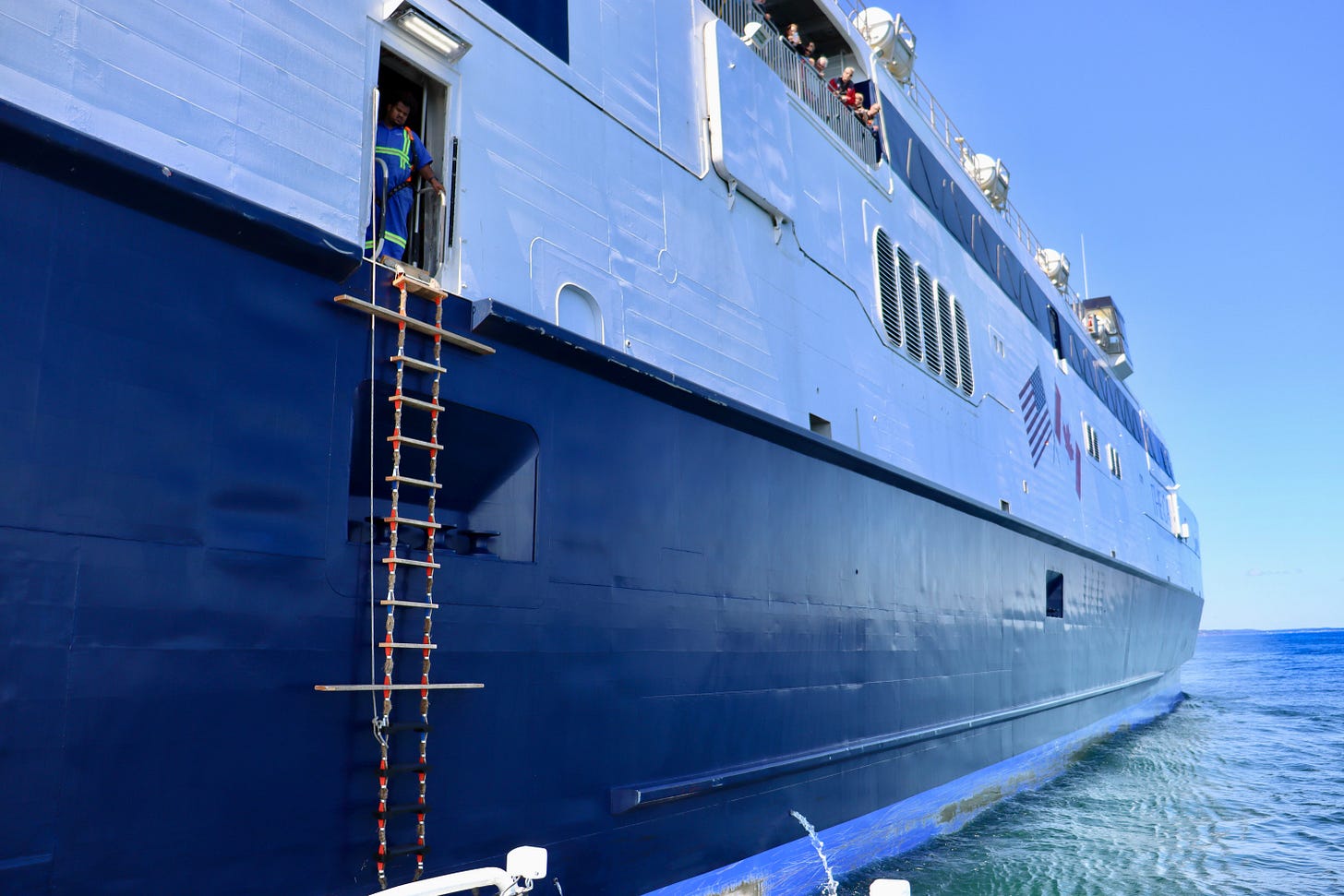
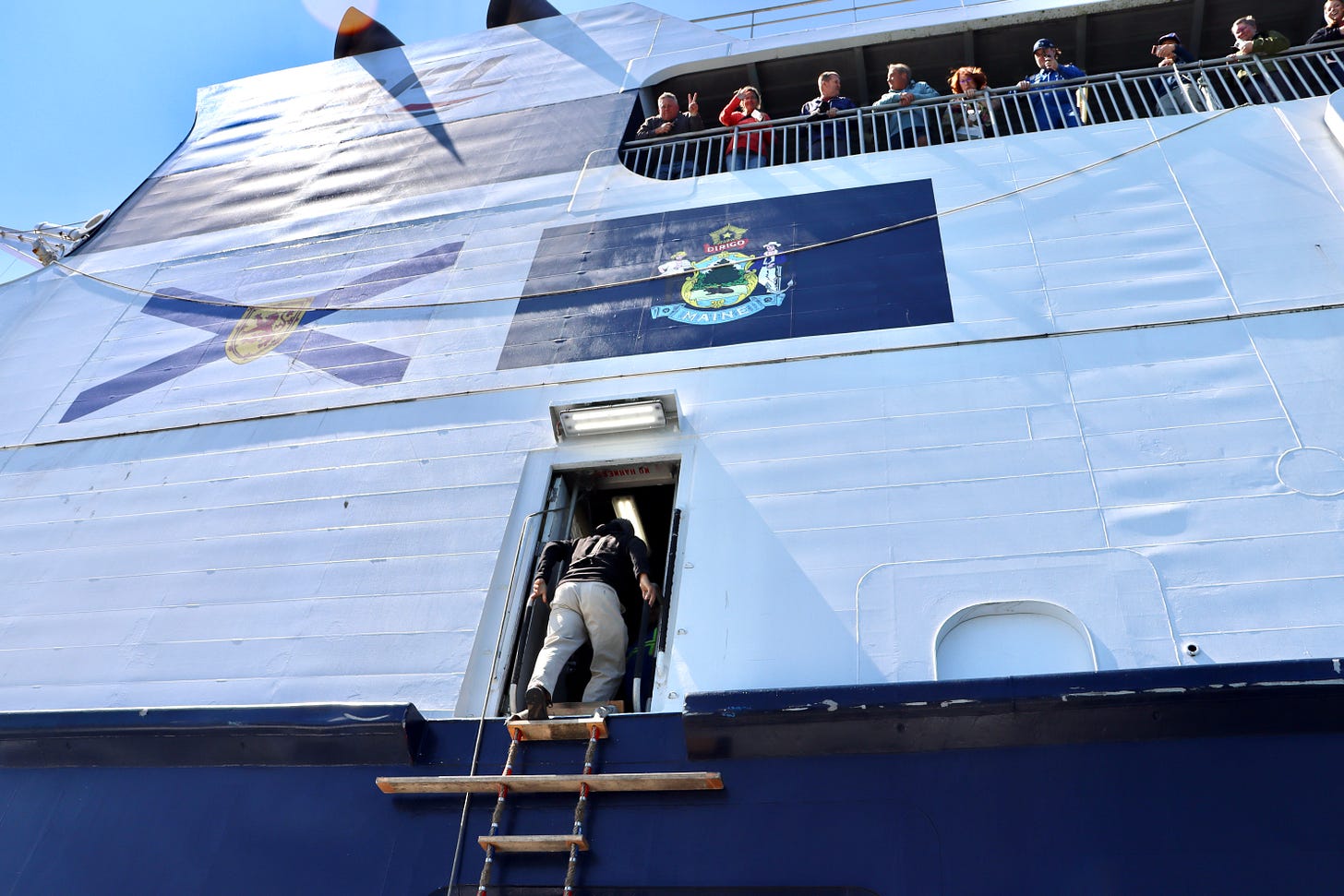
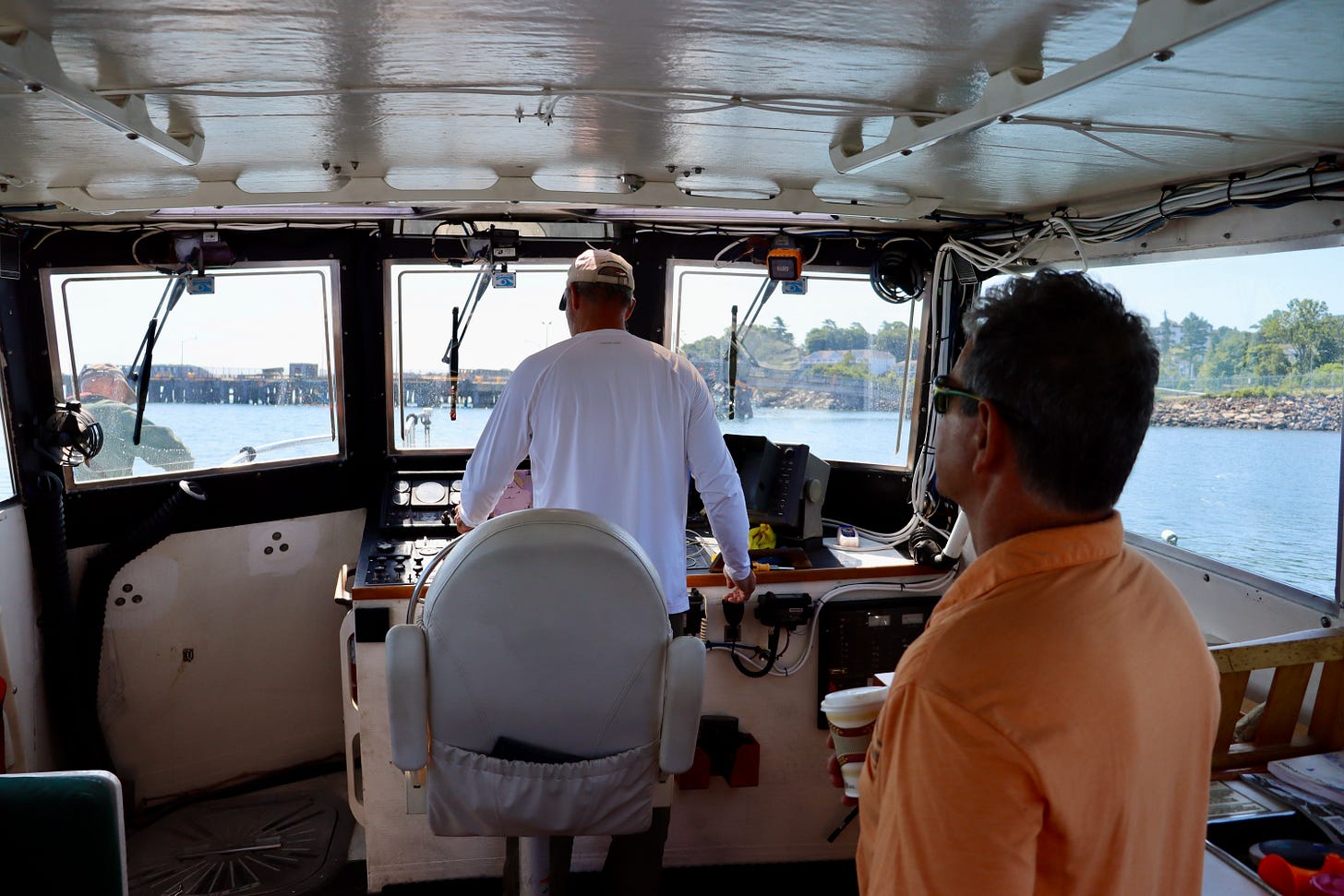
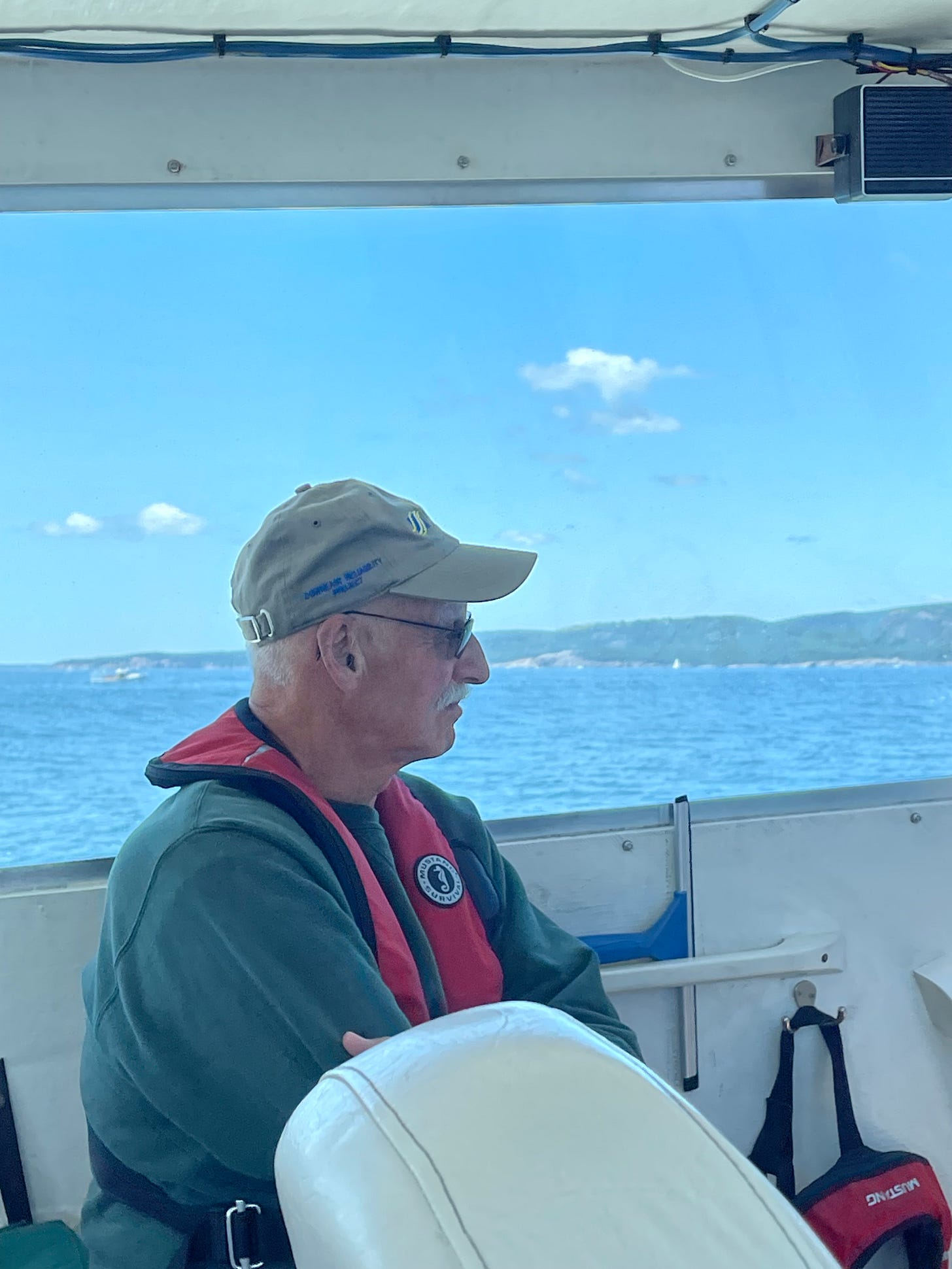
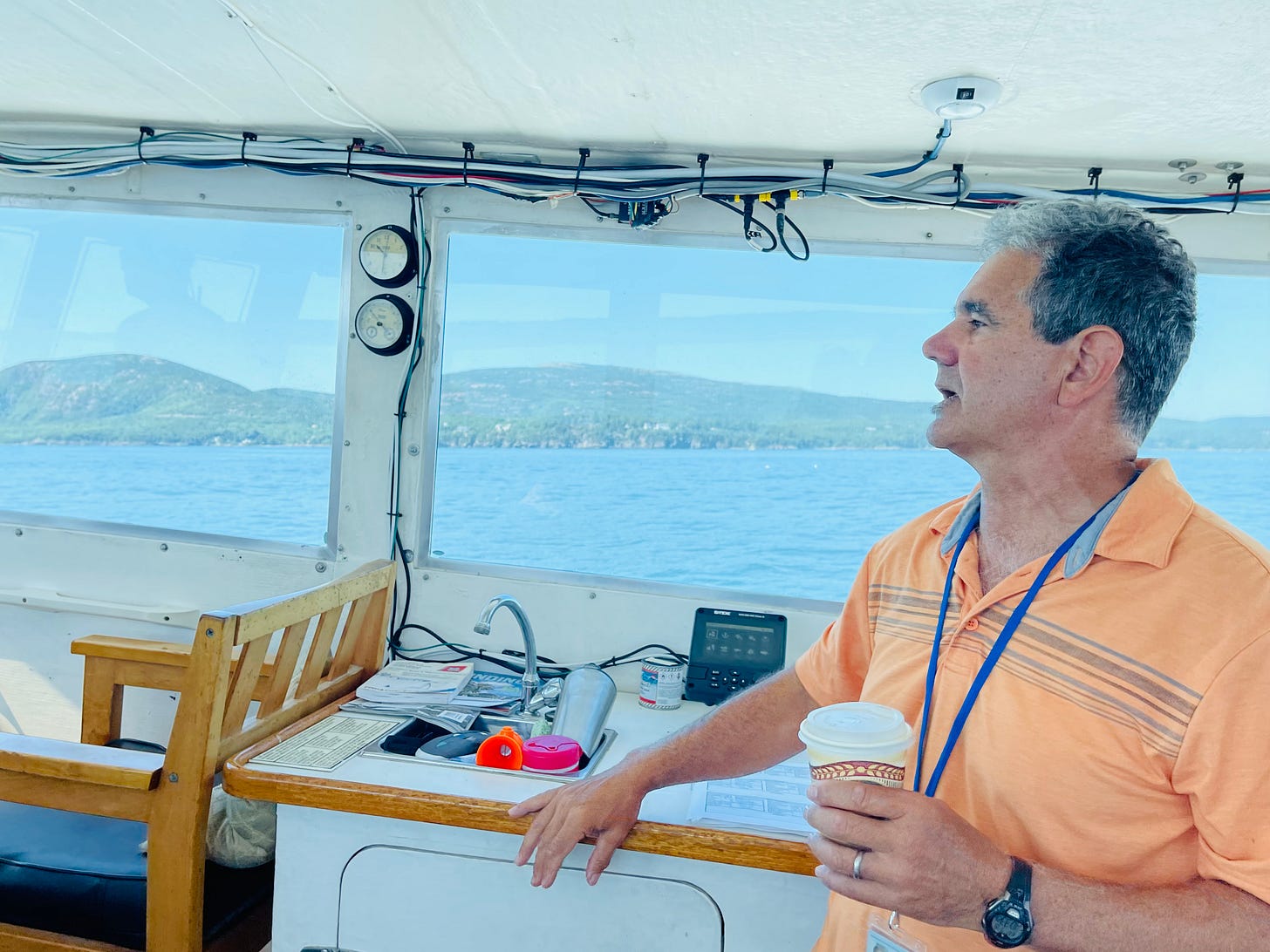
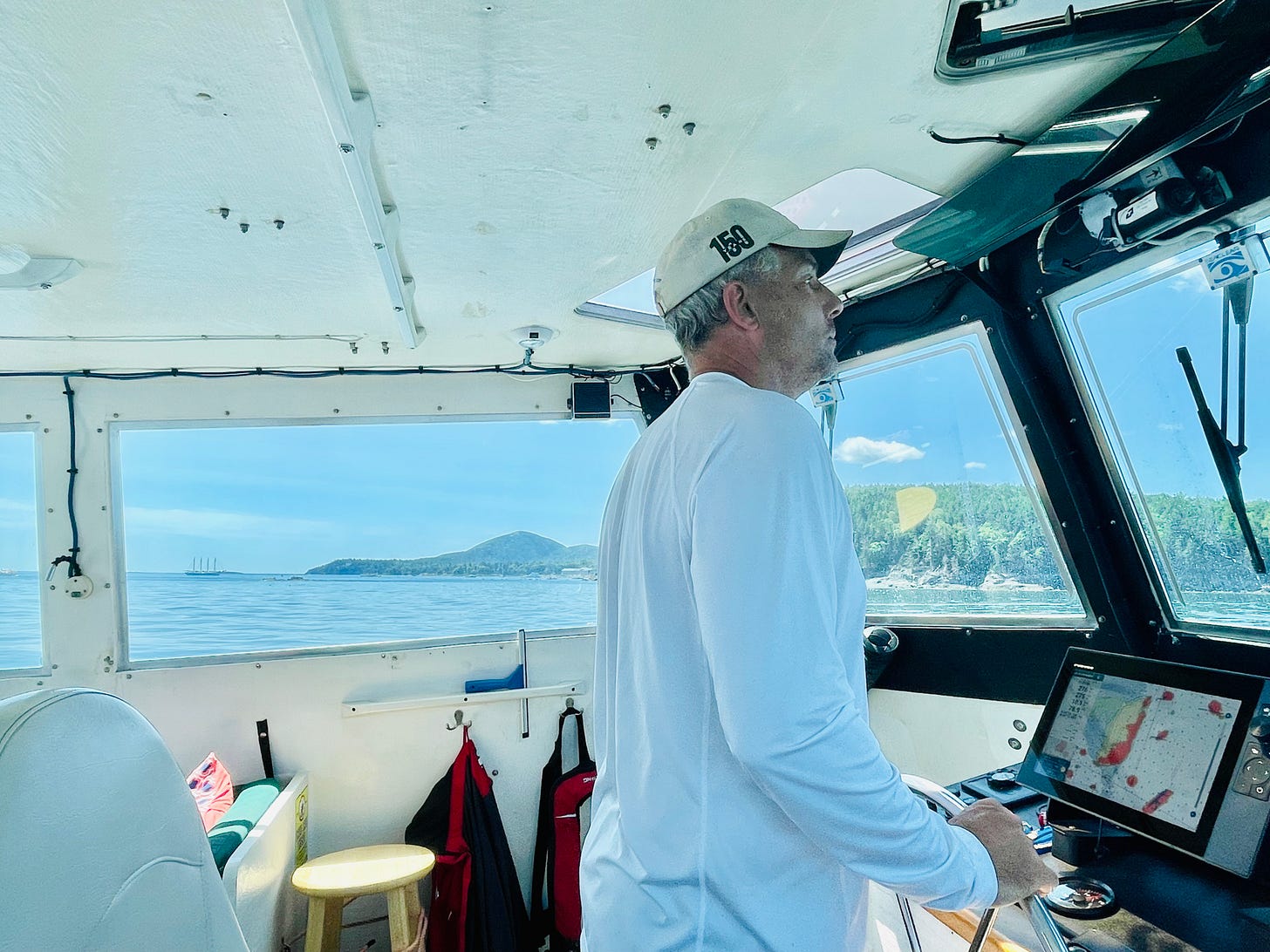
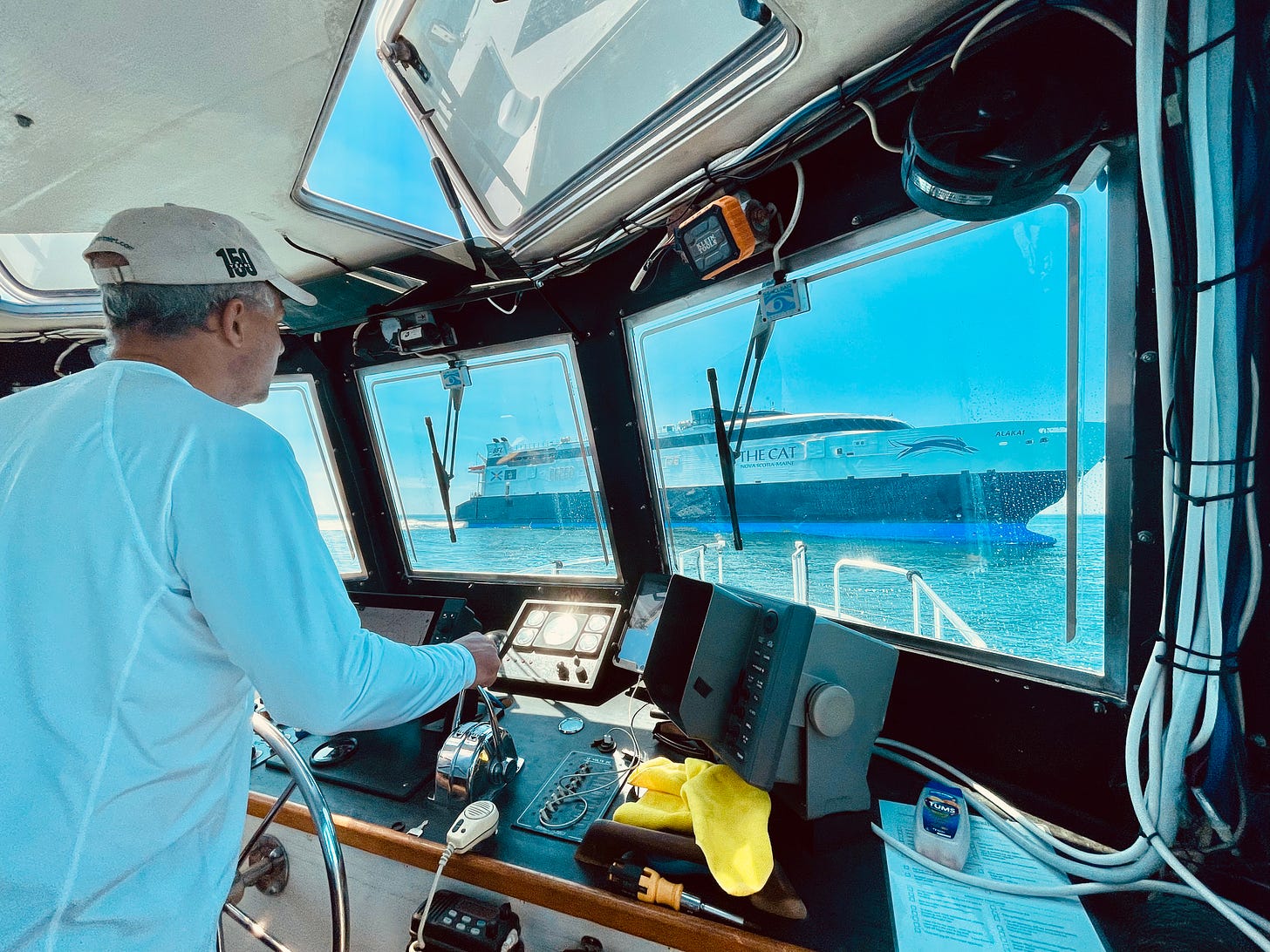

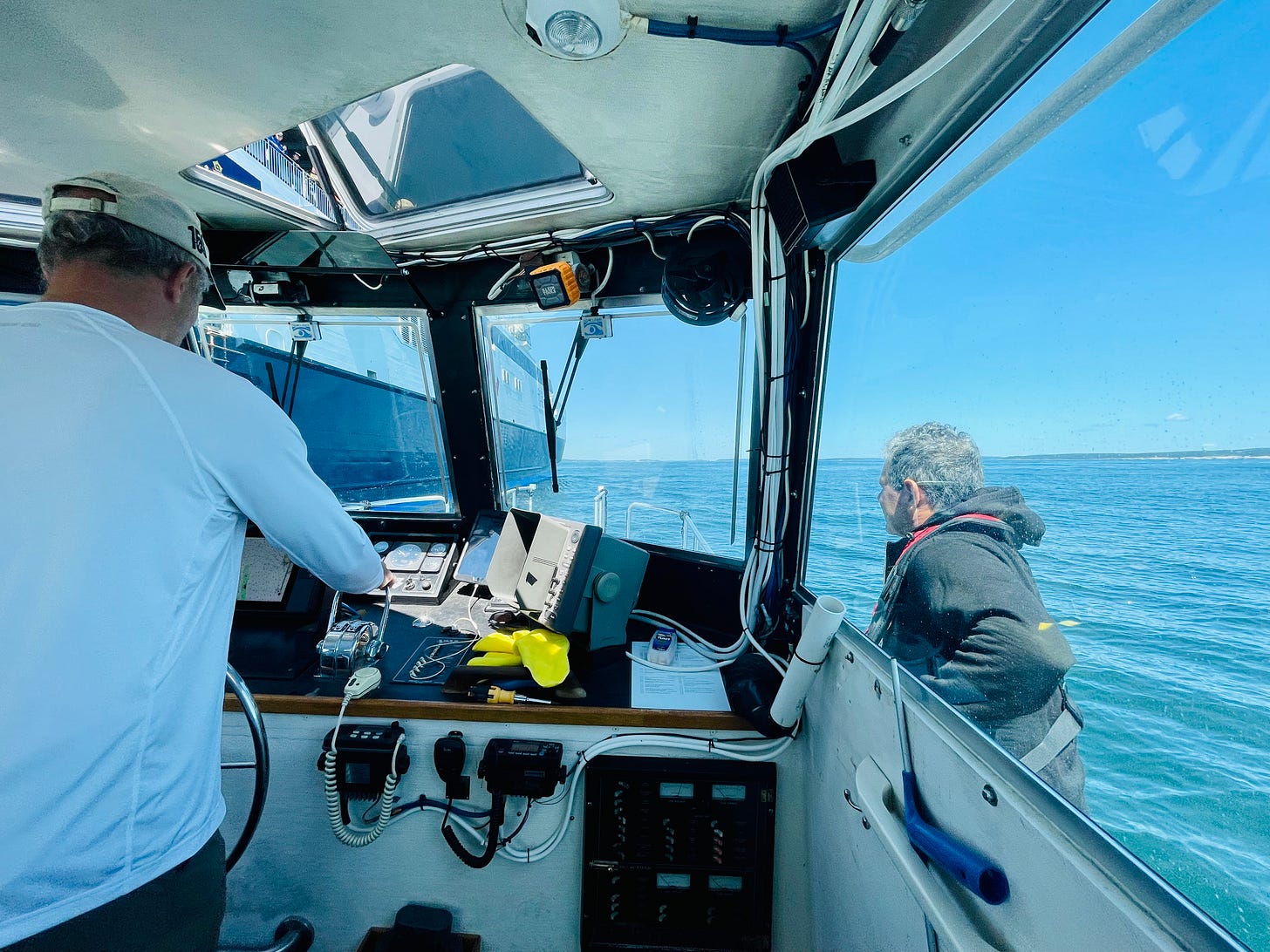
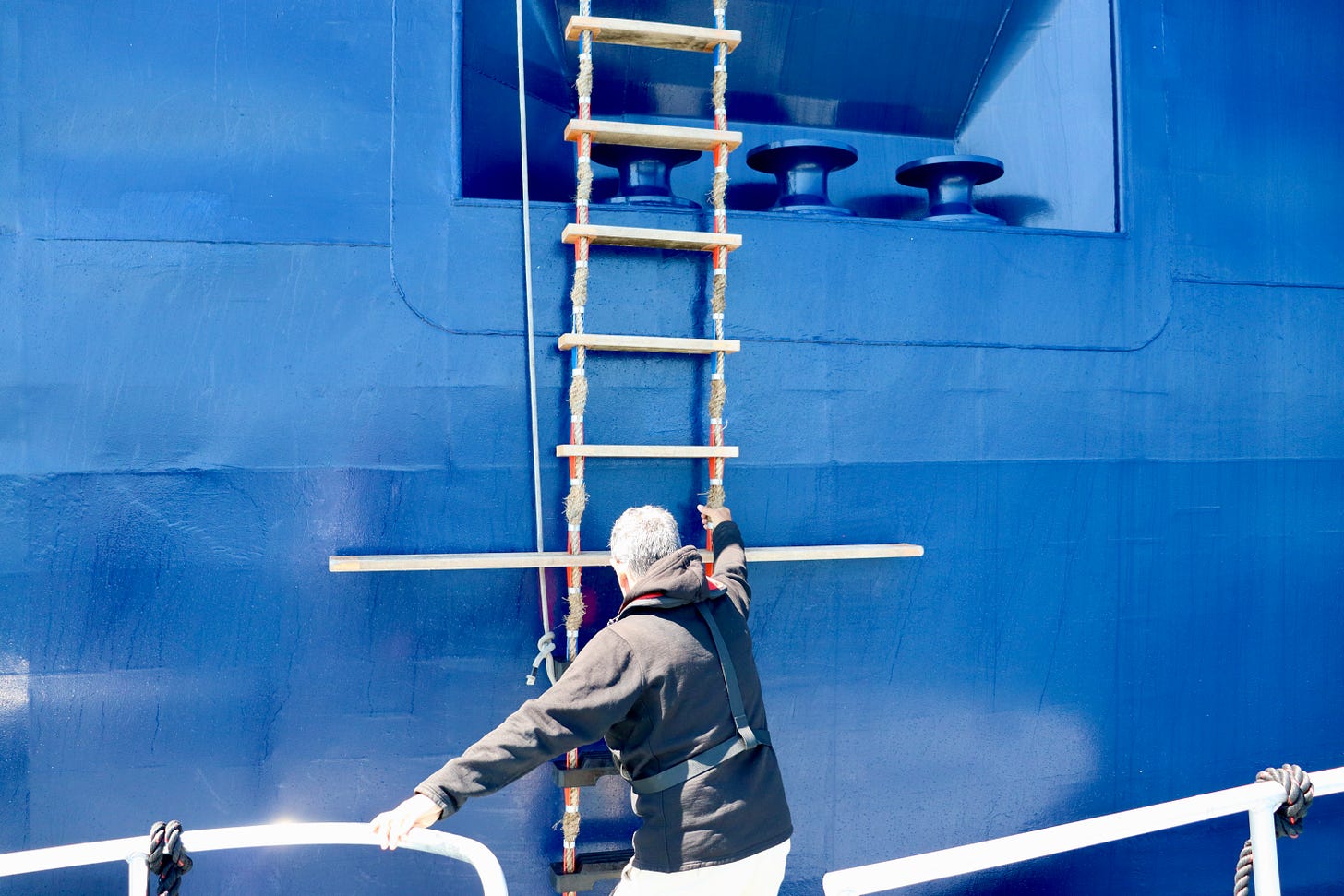
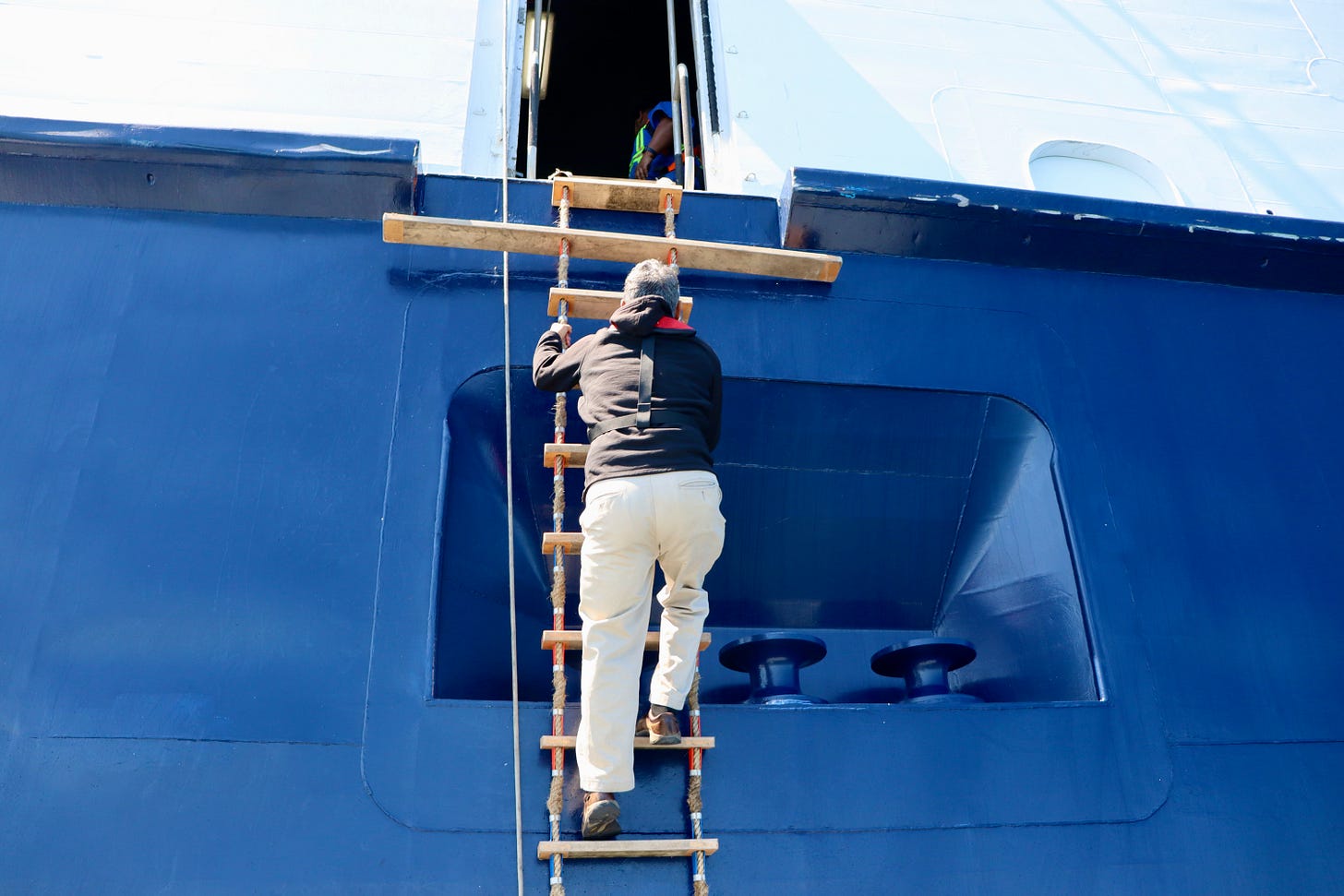
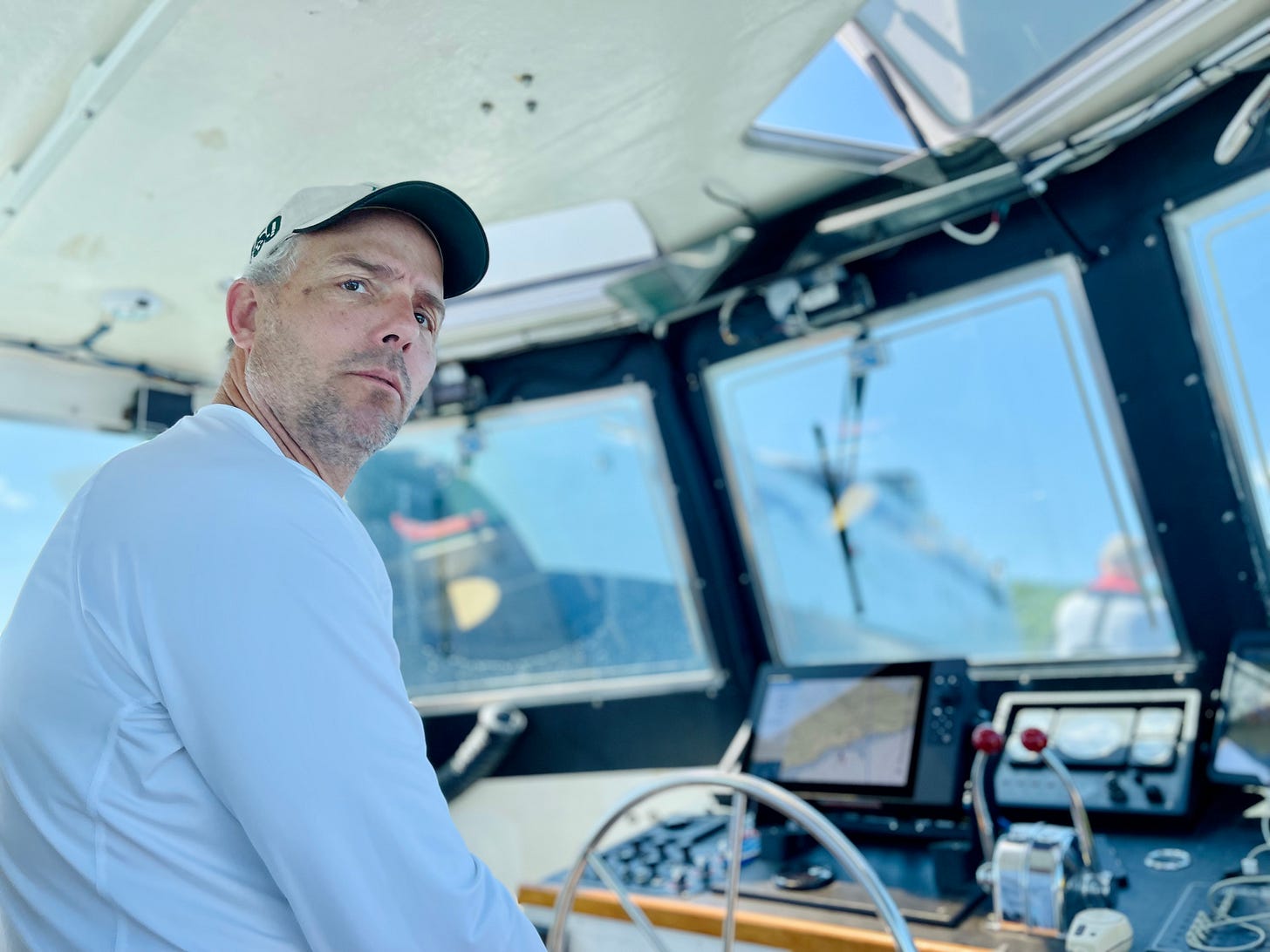
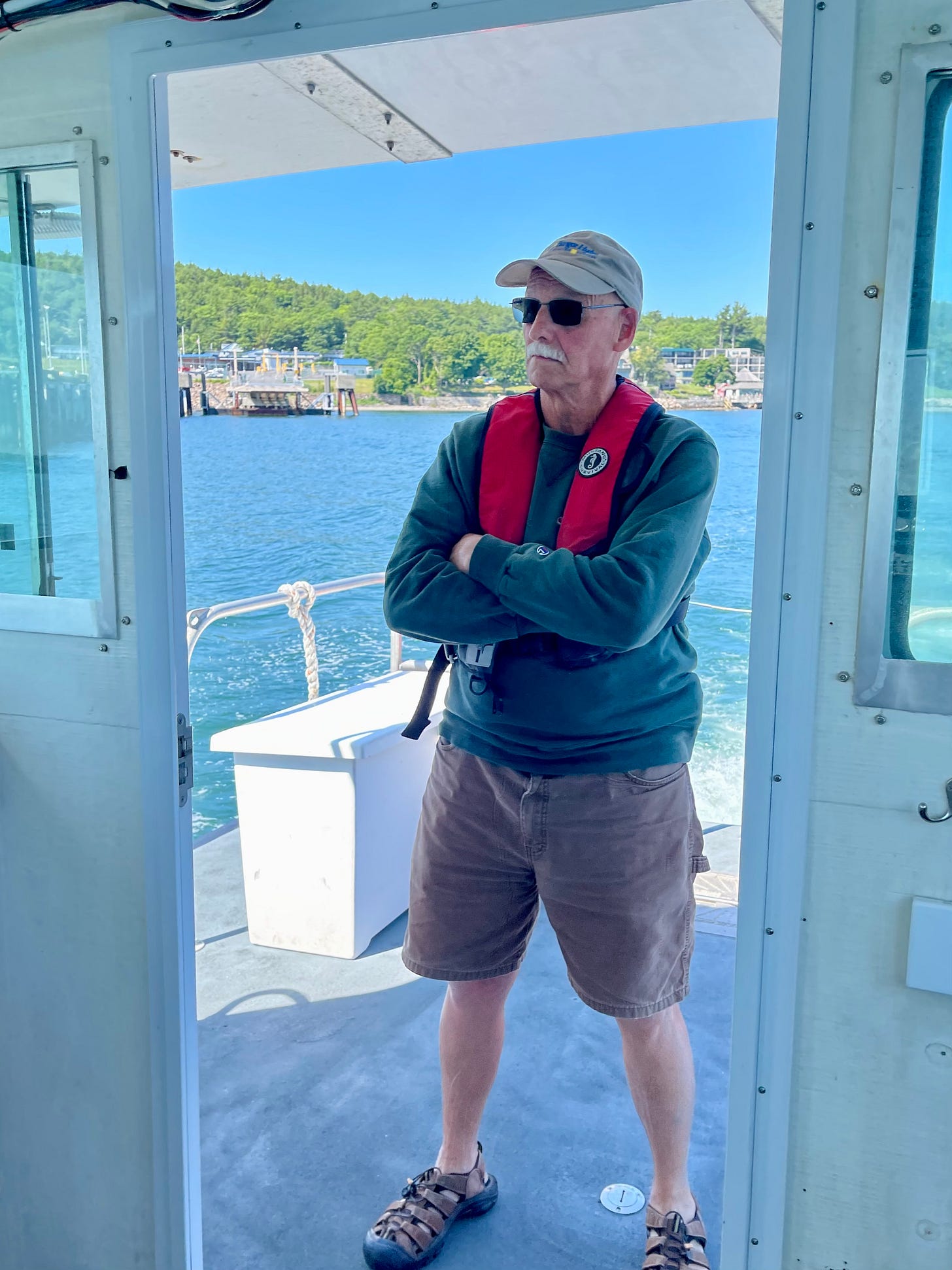
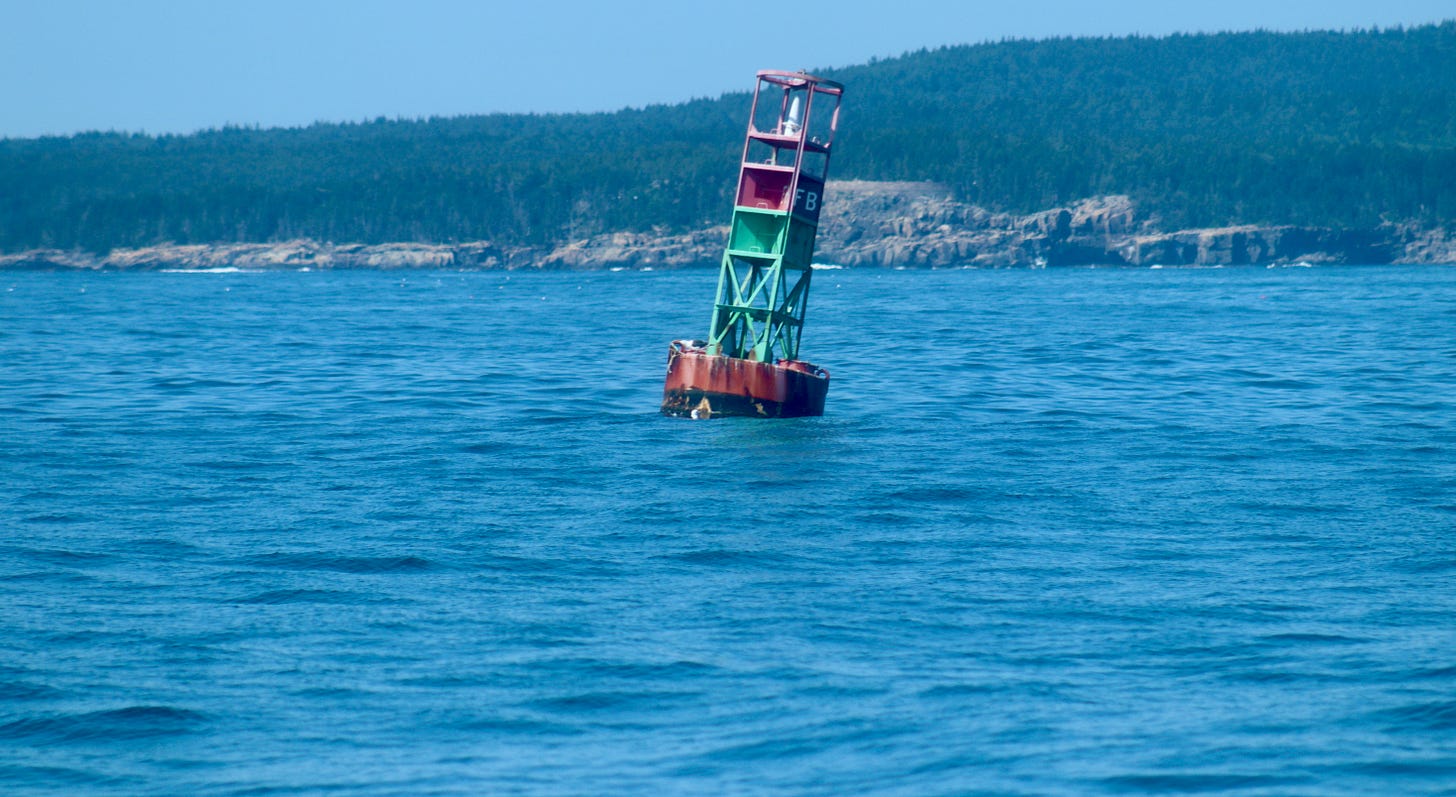
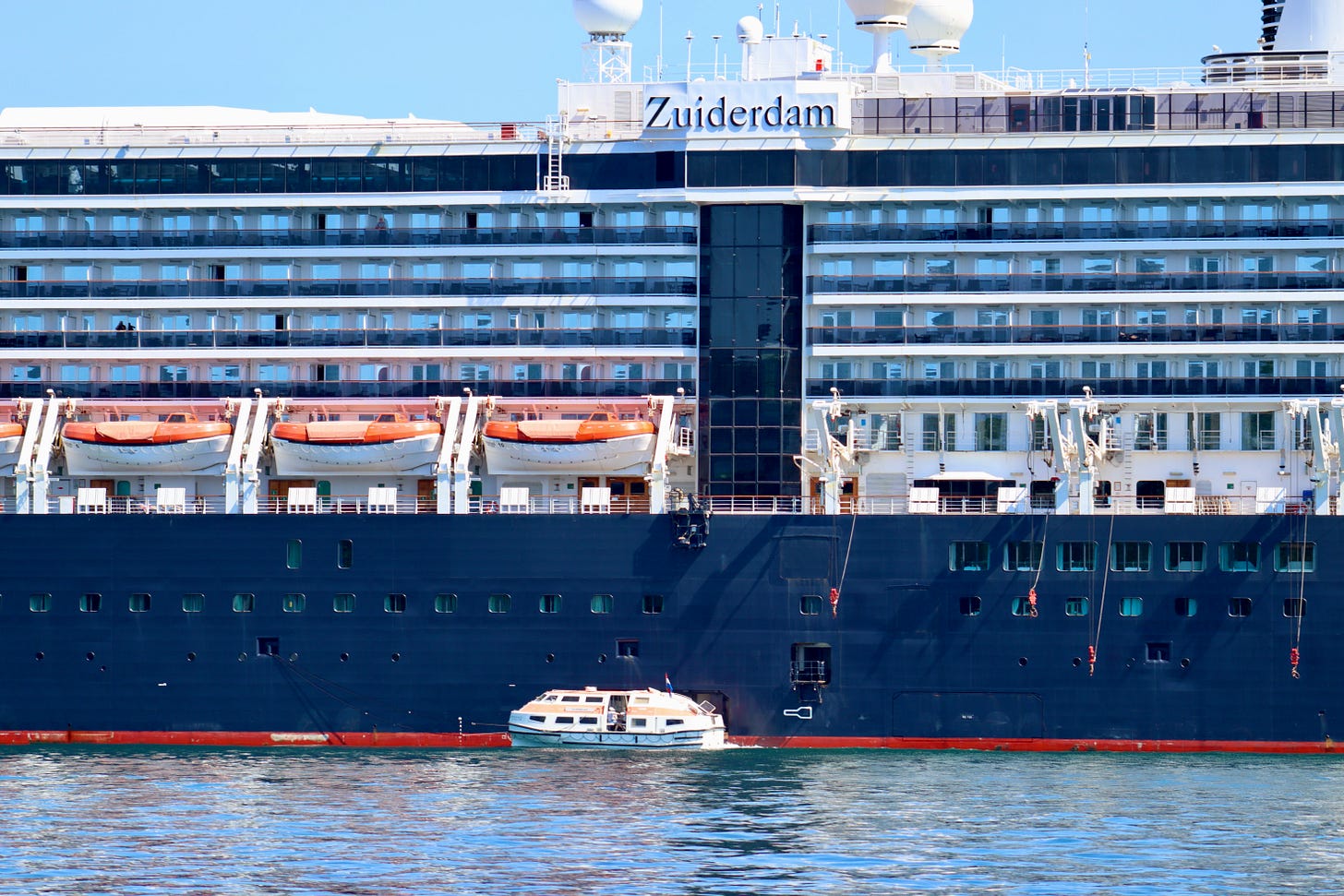
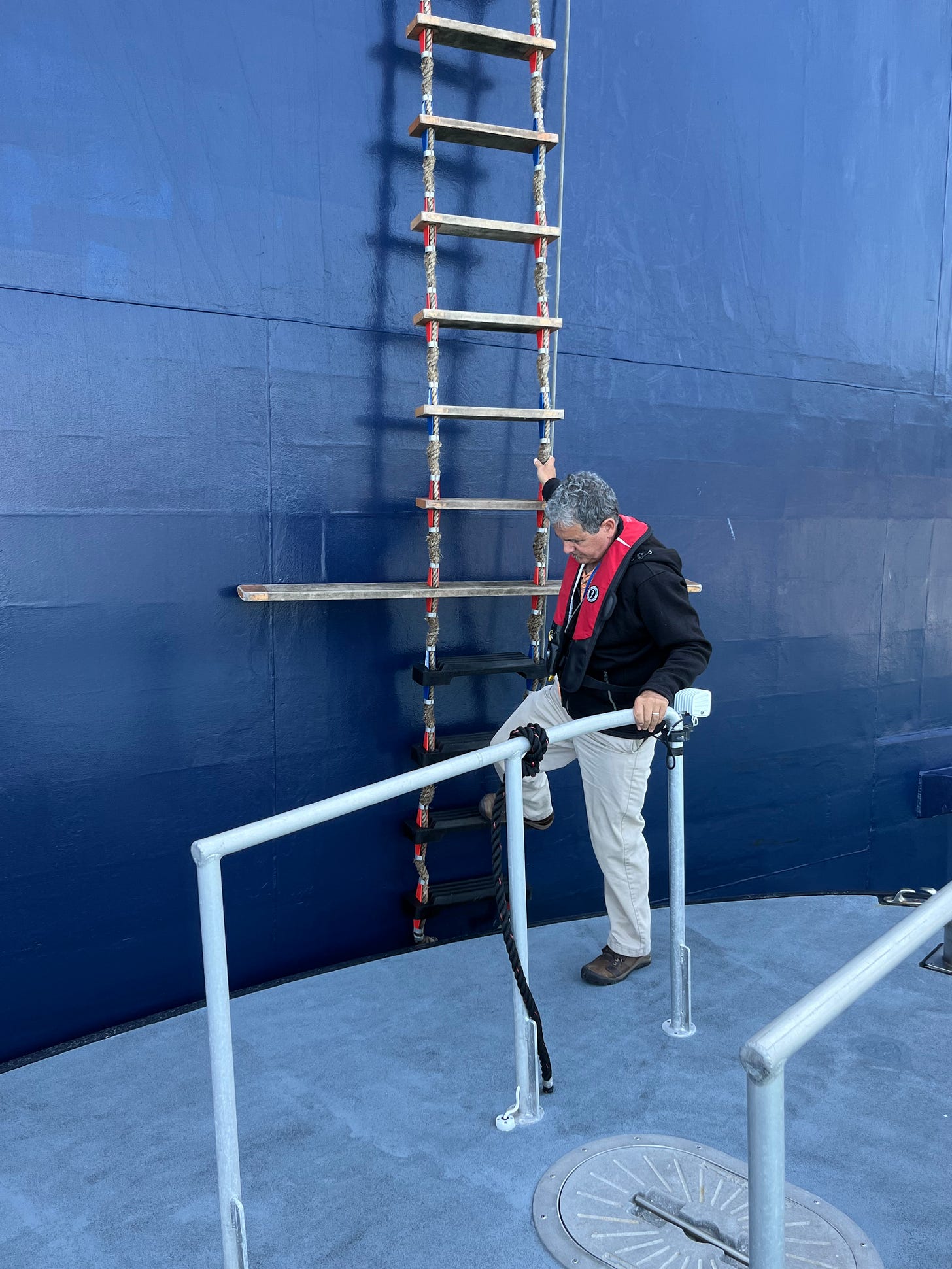

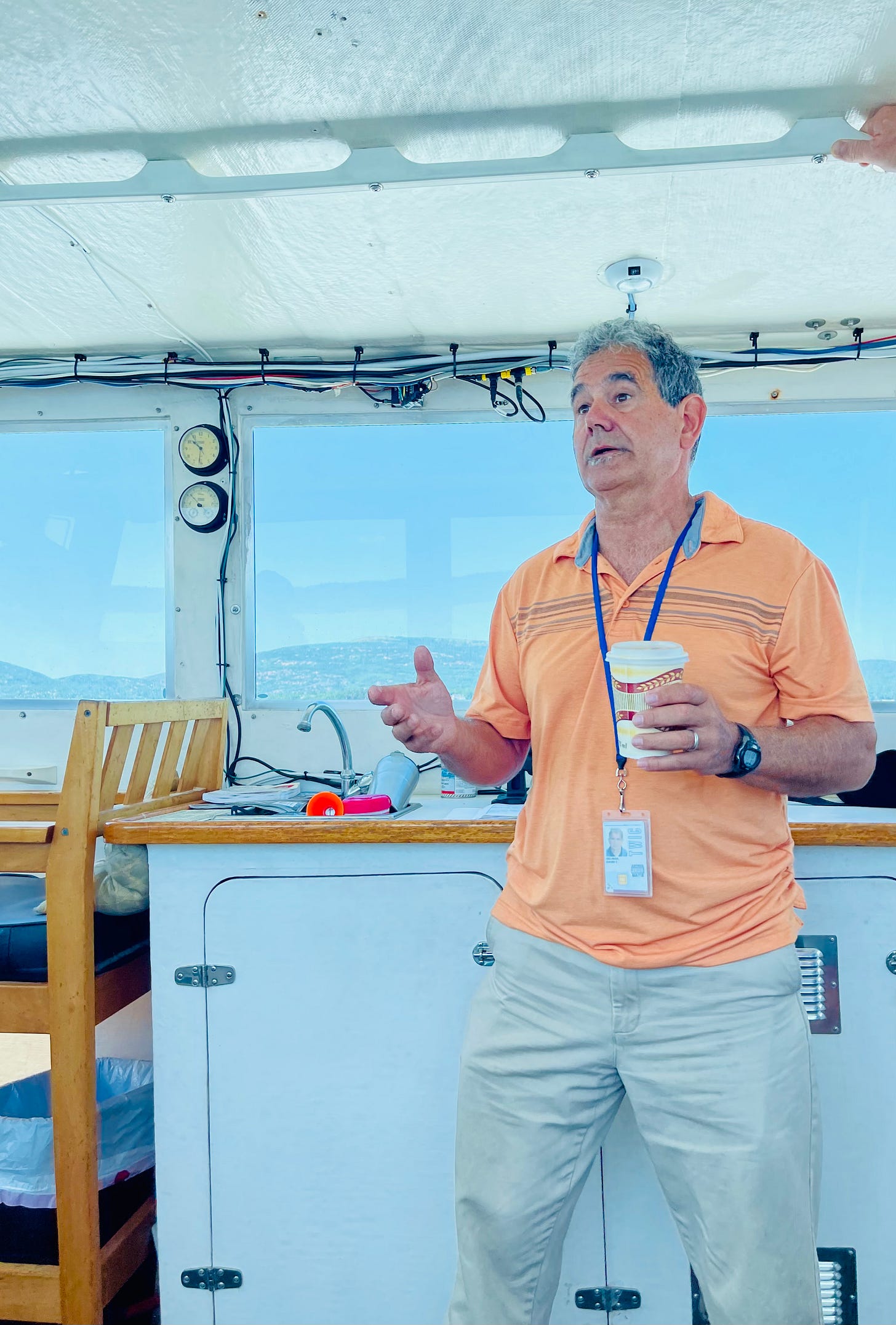
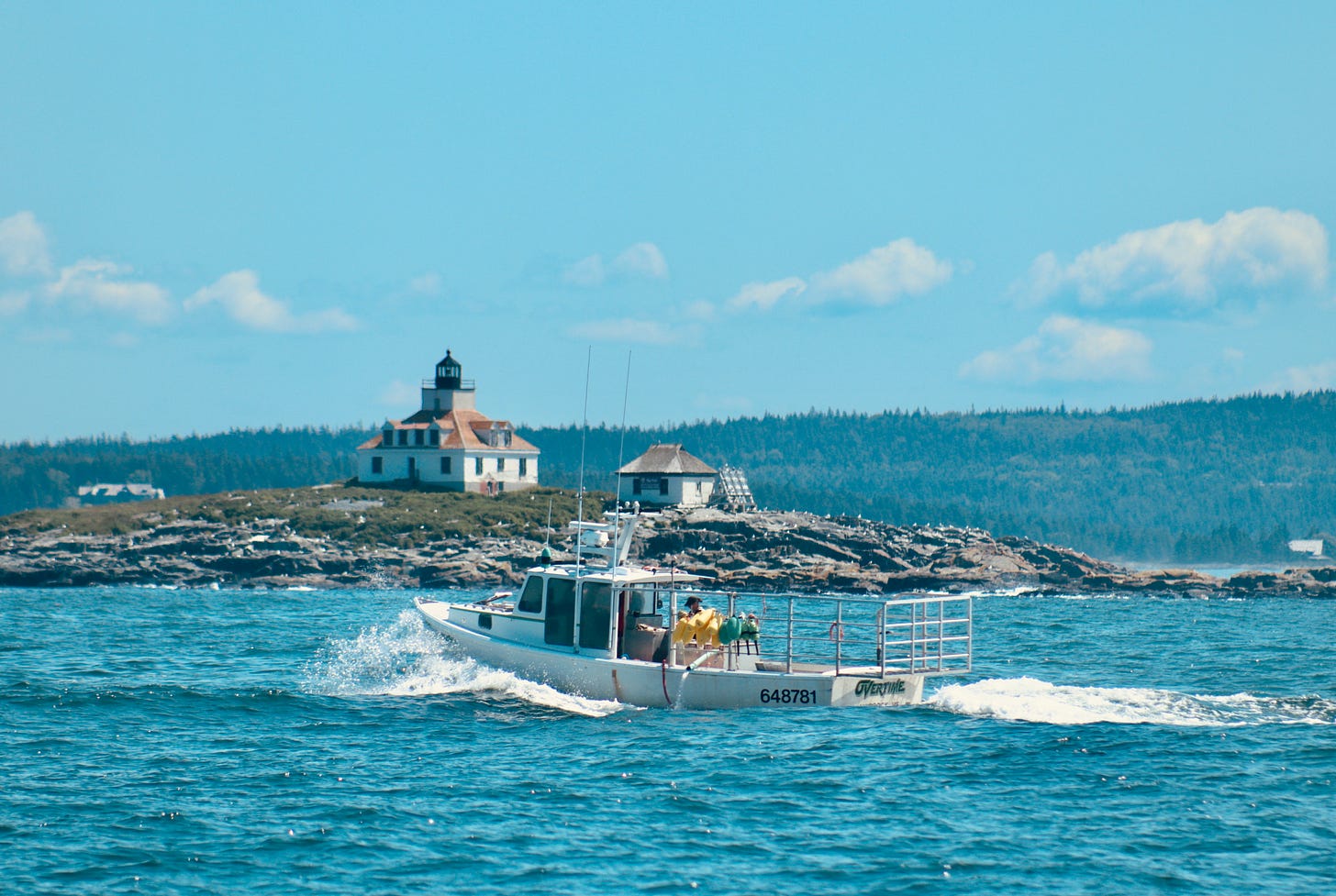
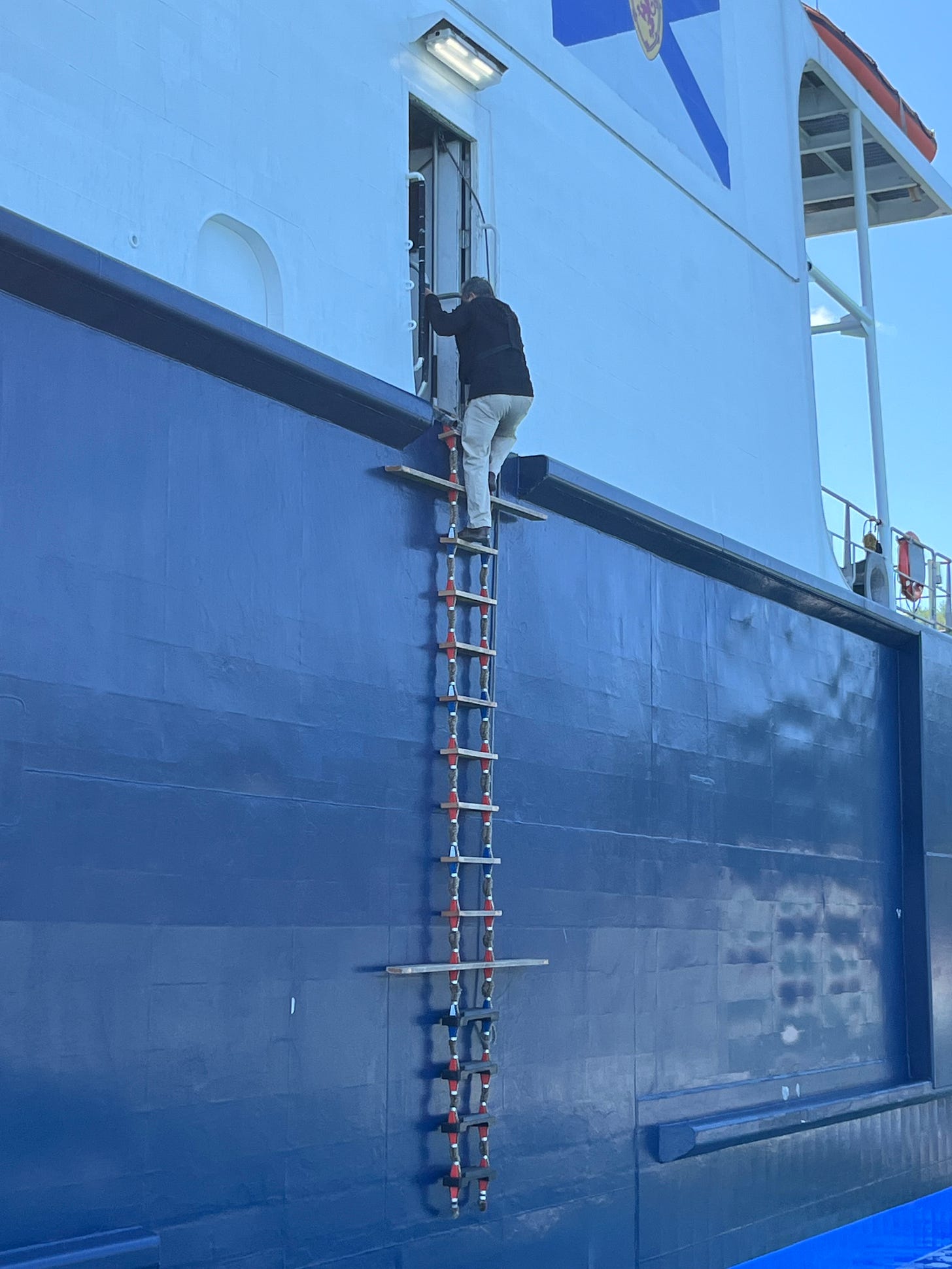
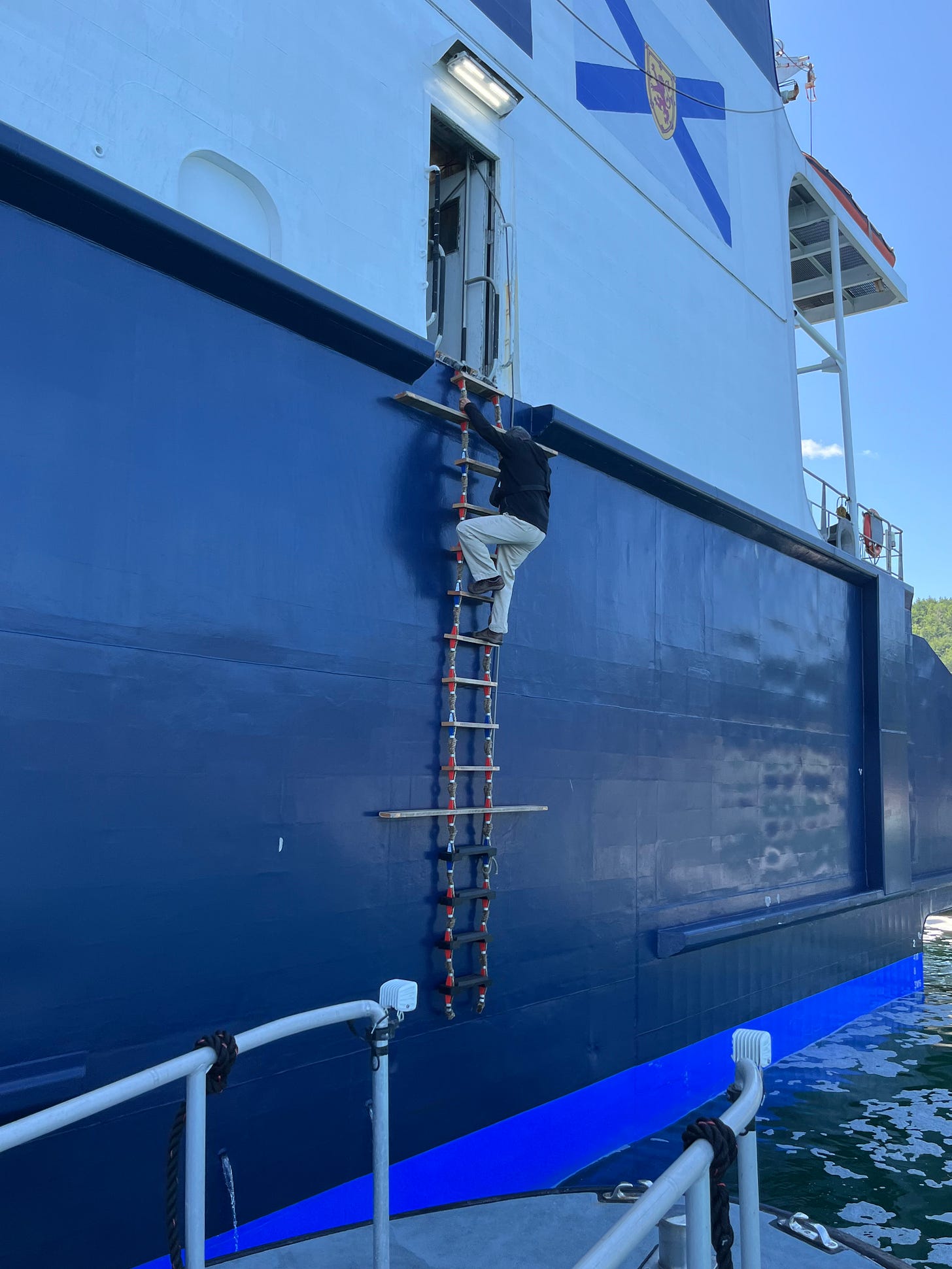

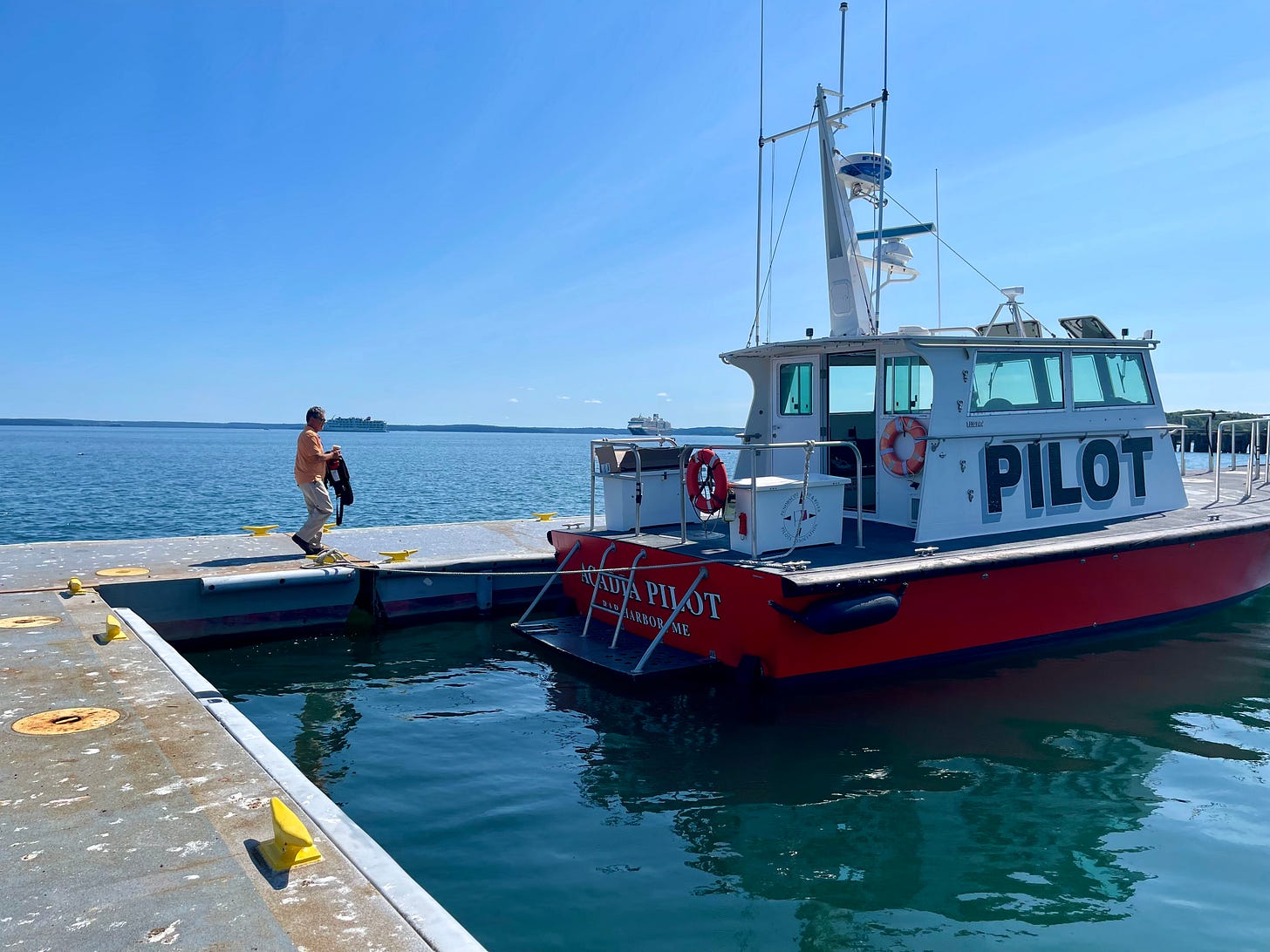
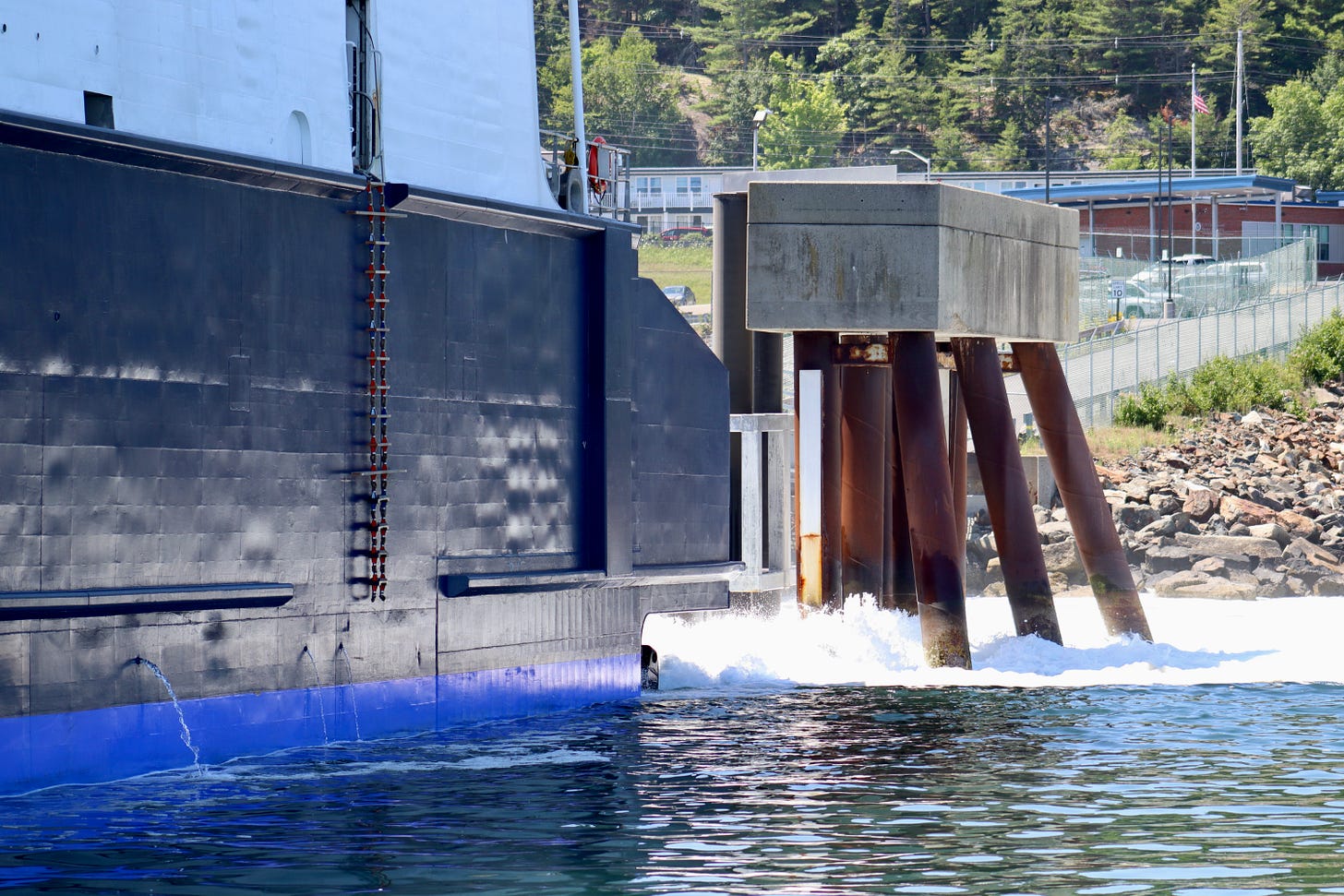
Larry who? An opinion without a name is as worthless as a check without a signature. Many publications simply will not print comments unless the author of those comments identifies themselves and takes responsibility for their statements. This "Larry" guy has repeatedly criticized the statements of others without providing a shred of evidence in support of that criticism and despite repeated requests has refused to identify himself. As to the harbor pilot issue I have held a USCG 50 ton Masters License for 30 years and for many years provided water transportation to ship's agents, custom officials, and occasionally to Pen Bay pilots themselves. So I am intimately familiar with piloting operations within Frenchman Bay. While there clearly is a need for skilled harbor pilots in busy commercial harbors with torturous shallow channels (NYC, etc) Frenchman Bay is not one of them. Miles wide and generally hundreds of feet deep the bay has very little commercial traffic other than lobster boats and sight seeing tours all of whom are more than capable of avoiding cruise ships usually traveling at relatively slow speeds. Between the outer Frenchman Bay entrance buoy and the outermost cruise ship anchorage (approximately 5 nautical miles) there are basically 2 "must avoid" obstacles: Egg Rock Light and Bald Porcupine Island. Water depths throughout this passage average around 150' with one small area of 70' depth. Cruise ships transiting to the anchorages further north must pass through a a 1/2 mile wide well buoyed channel between Sheep Porcupine and Burnt Porcupine Islands that has a depth of as much as 200' . Even without radar and the state of the art satellite navigation systems all cruise ships are required to carry any even semi competent cruise ship captain would have no problem whatever entering or leaving Bar Harbor without the aid of a harbor pilot under any conditions other than hurricanes. As to the Cat Ferry it was not until 2012 that they were even required to carry a pilot. As far as I know they have never collided with Egg Rock, Bald Porcupine Island, or Sheep or Burnt Porcupine. While this article conjures up images of stressed cruise ship helmsmen cranking a huge steering wheel back and forth, sweat running down their faces the reality is that the ship is being guided by a satellite navigation system that makes the one in modern automobiles look like a piece of junk. So why the requirement for harbor pilots in Frenchman Bay? Good question! Very good question indeed. Dare I suggest it has something to do with legislative lobbying and making money? The only real danger involved in cruise ships coming in and out of Bar Harbor is the sometimes tricky process of transferring a harbor pilot from the pilot boat to the cruise ship and back again, especially during rough conditions. Now there's some safety regulations that need tightening up!
The pilots have jobs in Eastport ,Searsport, Portland and have had those jobs for many decades. Bar Harbor does not want big ships.
It is clear that these few guys are not needed here anymore. No use crying about it. I was just down at the BH pier and the smell of diesel from the tenders serving the Zuiderdam was blowing out of the West right across the parking lot on the pier. If you can smell diesel it is a bad sign that it is at unhealthy levels. Asthma attacks happen at less than 1ppm which is way below the level you can smell. The tenders are emitting 1000ppm.
The pilots are simply steering harmful pollution into Bar Harbor. They are not needed. We should have figured this out long ago and never gotten involved with this dirty industry.